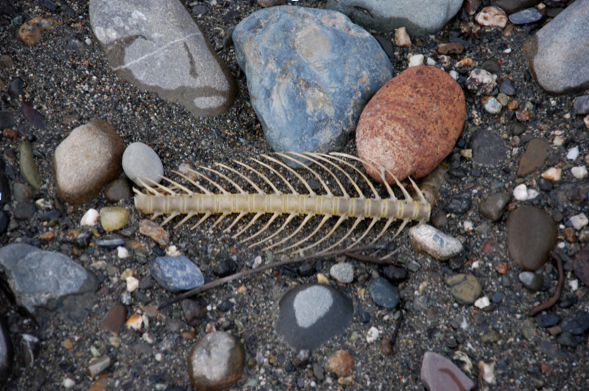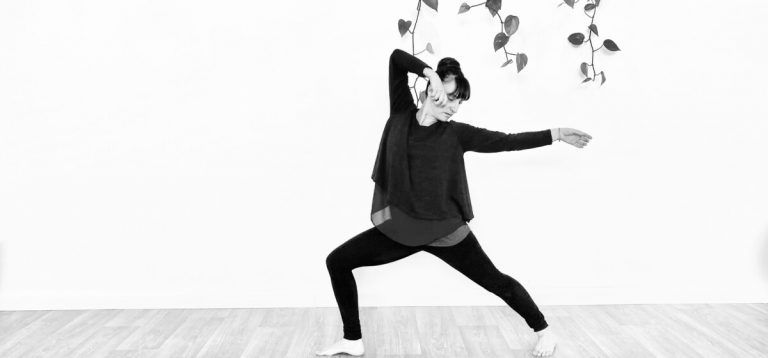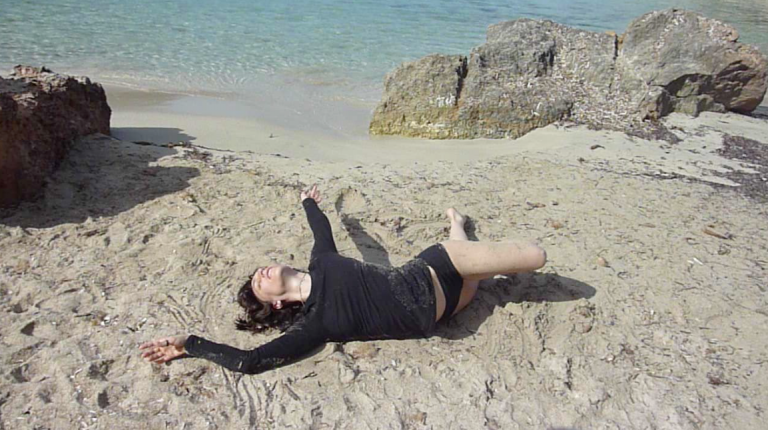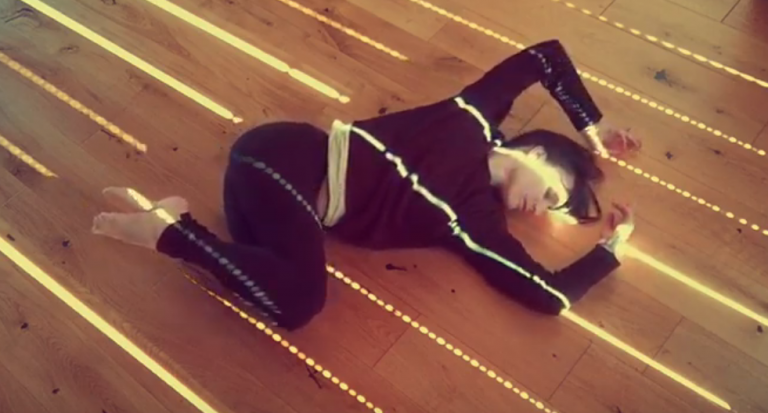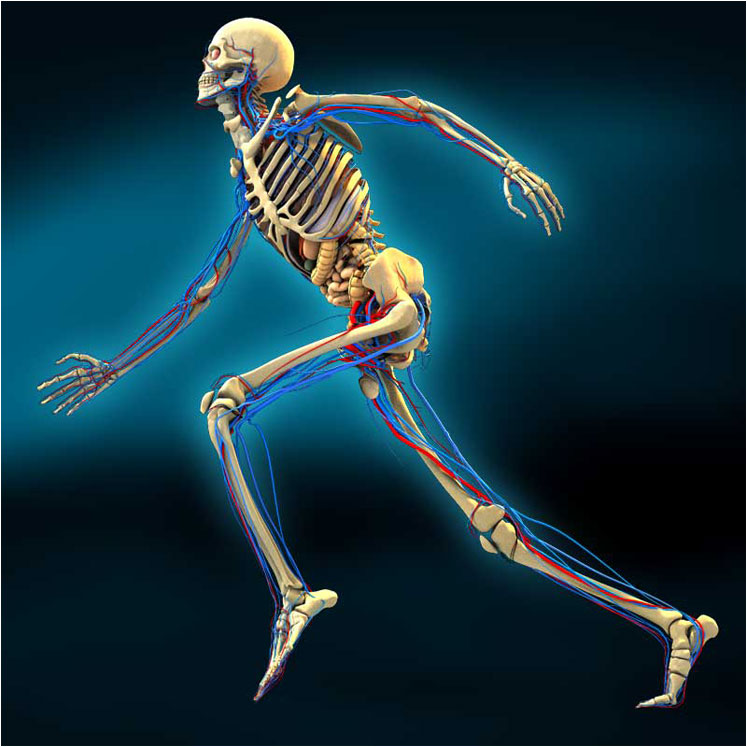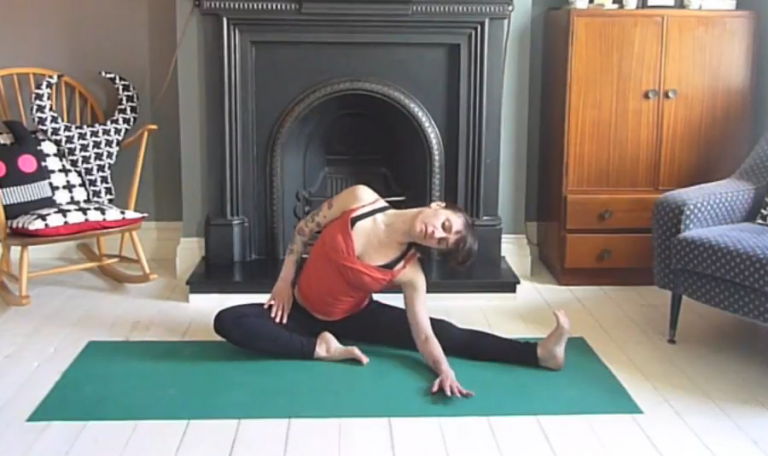Why Is It So Important To Feel Grounded?
One of the most important teachings I give in any Yoga Anatomy Workshop is to show students how to ground themselves. Before starting with the very basic, yet effective explorations in to how to do it, let’s study the definition of ‘grounding’.
One common definition of grounding is related to electricity supply systems; the Wikipedia definition says, “in electricity supply systems, an earthing system or grounding system is circuitry which connects parts of the electric circuit* with the grounded, thus defining the electric potential of the conductors relative to the Earth’s conductive surface”. So if we translate this in to a bodily definition it will give us a basic idea of grounding, or what we intend to feel as we do the explorations.
We are energy, our nervous system is an electrical system with an intricate connection of axons and neurons, which are in communication so as to make our organism to work with efficiency. When an electric circuit is grounded it works at its best because it can off-load excess current to the ground, and the same goes for us. The danger of an electrical appliance not being connected to earth is that any excess current of energy doesn’t discharge and thus creates an electric shock** or a short circuit***, and these terms apply similarly when the ‘appliance’ is our body.
The switch that connects us with the earth (the Power source) is awareness, intentional and sustained awareness, and the wires that the energy-information travels through is our nervous system. The “electric potential” will be translated here as the ideal amount of energy our human system needs to work without having a short circuit or give an electric shock.
Why can we be at risk of a short circuit or high voltage causing an electric shock? The answer is because we are not connected with Earth. We are not ‘Earthed’.
When muscles work they are in a state of tension. Tension is necessary in order to move the bones, but sometimes we store unnecessary amounts of this tension (high voltage) in key areas of the body. The same applies to the mind too and when mind is very active it also effects the state of our muscles, making them tense.
The work of grounding both allows us to release the unnecessary tension stored in the muscles and if we are out of energy supply (low resistant, short circuit) grounding will also give us energy, creating much needed balance to the nervous system.
If we can learn to release this unnecessary tension, we will feel more in touch with the physical weight of our bodies, the skeletal structure will become more apparent, and we will be gradually more able to sink into ourselves.
First when we want to ground ourselves we have to stop or slow down to be able to feel the gravitational pull of the Earth. Thanks to this magnetic healing force we have shape. Gravity causes the motion of the oceans and controls the orbit of the stars as much as it does the motion of our inner waters and if you learn to follow this force you will be able to feel connected with something greater than yourself and a sense of trust will arise as a result. We can call this living in the ‘here and now’, the ‘present moment’; this is a beautiful bodily meditation. In the Satipatthana Sutta (The Discourse on the Establishing of Mindfulness) a Buddhist practice designed for awakening to this present moment, this is the first foundation of mindfulness, breathing with the body.
Contact.
The way we start grounding is to establish contact with your body. Feel the areas where the body is touching the ground… then wait, listen, and you will be informed about the sensation and experience of the present moment, starting to have a clear understanding of what are you feeling as you begin to connect.
Contact is the act of registering experience, contact depends on where your attention is, and when we experience contact there’s a shift, something resonates, something lightens up, there is a somatic and emotive effect that comes with this practice which affords you the feeling of being in the flow, something good is happening!
One of the most effective positions to ground yourself is Constructive Rest Position. This particular exploration I learned in a workshop with Liz Koch
Constructive Rest Position
“Constructive rest position is not a doing position. It is a being position” – Liz Koch
Lay down on the floor with your knees bent, you can use a strap around your thighs if your knees tend to fall out or put a block in between if your knees tend to drop inwards. Make sure the knees are aligning with your hipbones. Your feet are neither too far apart of your pelvis, otherwise you won’t be able to connect your feet on the floor, thus loosing skeletal support for your legs, and neither should your feet be too close to the pelvis as the tendency then is to drop the pelvis and loose the natural curve of your lower back.
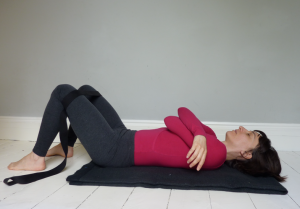 If you are over extending your neck then place a block or a hard cushion underneath your head. Placement of your arms must be confortable, you can put palms on your belly, cross the arms and rest them on your chest, or let the arms to be by the side of your body with palms either facing up or down, feel what is best for you.
If you are over extending your neck then place a block or a hard cushion underneath your head. Placement of your arms must be confortable, you can put palms on your belly, cross the arms and rest them on your chest, or let the arms to be by the side of your body with palms either facing up or down, feel what is best for you.
Once you’re in the position allow your mind to drop in to the sensations of the body, touch the body with your mind, making contact with an open awareness. Choose any sensation that is speaking the loudest to you and follow it. You will discover the sensation will start to be stronger, it will maybe travel or perhaps you will observe how it fades away. Discover in which parts of your body you store the tension, usually the area will feel as iff they are off the ground. Do not make anything to change it, just observe.
Breath is part of the experience
Feel how the breath moves the body as well as which parts of the body moves as you breathe. Observe the qualities of the breath. For instance the inhale might feel expansive, bright, energetic etc. The exhale may feels like a dropping, letting go, soft etc. You name it, how it is for you. As you become more comfortable observing the breath or the movements of breath you will begin to notice that the breath will regulate itself becoming more deeper an slower, then send the inhalation deep down to your pelvis and allow the exhale to soften the body. Try this for a few minutes, widening and feeling the movements of pelvis and breath.
Now, on this stillness observe all the events that are happening. You will realize that there are so many things going on inside the body, of and by themselves, and to be aware of them you just need to sustain an open awareness.
The body has the capacity to heal itself and is a truly incredible experience to be able to observe this process, witnessing the miraculous nature of our intelligent system adjusting itself in to the new experience. Feel how the muscles start to soften, then feel how the skeletal structure starts to move as the muscles start to lose the tension, and then in turn feel how the body start to drop in to alignment, reviling the natural curves of the spine
It takes 10 to 15 minutes for the nervous system to ‘record’ this new information, so make sure you have the necessary time for doing this.
Match your sensations with your senses, the external stimuli coming form the environment, for example; how does it feel the air on the skin, how does the light coming trough your eyelids feel as you are doing the posture, the smell of the room you are laying down, the warmth of the clothes, the sounds all around you? This somatic exploration will help the nervous system to create new neuro-pathways and so create change.
Whatever the state of the nervous system is, whether in high voltage or low resistance, this grounding exercise will bring you back in to balance.
Standing at the bottom of the sea, known as Zhan Zhuang (standing Qigong)
This standing exploration I learned it with my dearest teacher Ajahn Succito in his last 10-day silence retreat at Amaravati Monastery before his retirement.
Stand with your feet shoulders width apart, toes slightly pointing out, close your eyes and feel how your feet make contact with the ground. Start to bring the weight of your body towards the heels, lets say 70%, then bend the knees to create counterbalance. Soften the lower back around the area of the kidneys and feel how the belly starts to soften, then allow the pelvis to settle in to a confortable position. The weight of your body is spread equally on both feet. Release the lower jaw, this doesn’t mean that your mouth will hang open, just soften the jaw (the temporo-mandibular joint) with your lips remaining closed.
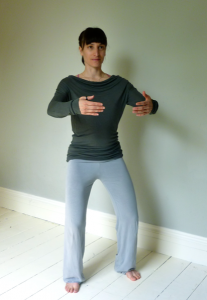 Settle down in this position. The body should be as soft and relaxed as possible. Allow the arms to hang from the collarbone, the head balanced right at the top on the spine, and if your eyes are open you are looking at the horizon or slightly down. Once you feel yourself settling in place lift the arms very slowly from your wrists, feeling the weight of your arms, letting go, loosening the shoulder joint. Try this up and down fluid movement a few times, checking for tension at the shoulder or neck. Once you feel your arms comfortably at ease in front of your chest turn your palms as if you are embracing a big balloon.
Settle down in this position. The body should be as soft and relaxed as possible. Allow the arms to hang from the collarbone, the head balanced right at the top on the spine, and if your eyes are open you are looking at the horizon or slightly down. Once you feel yourself settling in place lift the arms very slowly from your wrists, feeling the weight of your arms, letting go, loosening the shoulder joint. Try this up and down fluid movement a few times, checking for tension at the shoulder or neck. Once you feel your arms comfortably at ease in front of your chest turn your palms as if you are embracing a big balloon.
After a sustained period of time doing so observe how the body starts to stabilise itself. It feels as if you where standing on the bottom of the sea and being moved by the currents of water. You can try to create kinaesthetic images to create a richer experience, a mental picture or image of being on the ocean floor, moving with it’s ebbs and flows of it helps.
This grounding exploration will bring a sense of aliveness to your system and awareness and release to your postural-stabilising muscles, or antigravity muscles, which act predominantly to sustain your posture in the gravity field. These muscles contain mostly slow-twitch muscle fibres and have a greater capacity for sustained work, they are prone to hyperactivity and they tend to shorten.
Standing in the bottom of the sea will help to download the excess of energy and feel mentally grounded while acquiring internal power.
Movement in stillness
Slow movements are felt in the feedback loop of the somatic experience as heat, movements of breath, undulations, flow, little adjustments and more, all this are properties of Prana, or Qi, both ancient Sanskrit and Chinese terms for ‘life fierce’ or ‘natural energy’. This little involuntary events triggered by kinesthetic visualization are movement in stillness.
Stillness in movement
Postural muscles are very active during slow transition between postures, when using intent to guide your postural muscles to lift your arms, you won’t feel any effort, and this is stillness in movement.
*An electric circuit is like a pathway made of wires that electrons can flow through. A battery or other power source gives the force (voltage) that makes the electrons move. When the electrons get to a device like a light bulb, your computer, or a refrigerator, they give it the power to make it work.
** The term high voltage usually means electrical energy at voltages high enough to inflict harm on living things
***Short circuit. A low-resistance connection between two points in an electric circuit through which the current tends to flow rather than along the intended path. A short circuit can damage the circuit by overheating.

